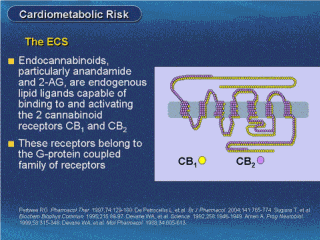| front |1 |2 |3 |4 |5 |6 |7 |8 |9 |10 |11 |12 |13 |14 |15 |16 |17 |18 |19 |20 |21 |22 |23 |24 | 25|26 |27 |28 |29 |30 |31 |32 |33 |34 |35 |36 |37 |38 |39 |40 |41 |42 |43 |44 |45 |46 |47 |48 |49 |review |
 |
There are 2 known endogenous cannabinoid
receptors—CB1 and CB2. Endogenous ligands shown to bind to these receptors
have also been identified. These ligands include anandamide and
2-arachidonyl glycerol (2-AG). Levels of 2-AG are much higher than anandamide, and 2-AG is thought to be involved in several other metabolic pathways. Anandamide and 2-AG exert their actions by binding to and activating the cannabinoid receptors. CB1-R and CB2-R activation leads to: Inhibition of adenylate cyclase Stimulation of mitogen-activated protein kinase Inhibition of voltage gated Ca2+ channels (CB1-R only) Cannabinoid receptors are G-protein coupled receptors consisting of 7 transmembrane-spanning domains Pertwee RG. Pharmacology of cannabinoid CB1 and CB2 receptor. Pharmacol Ther. 1997;74:129-180. De Petrocellis L, Cascio MG, Di Marzo V. The endocannabinoid system: a general view and latest additions. Br J Pharmacol. 2004;141:765-774. Sugiura T, Kondo S, Sukagawa A, et al. 2-Arachidonoylglycerol: a possible endogenous cannabinoid receptor ligand in brain. Biochem Biophys Commun. 1995;215:89-97. Devane WA, Hanus L, Breuer A, et al. Isolation and structure of a brain constituent that binds to the cannabinoid receptor. Science. 1992;258:1946-1949. Ameri A. The effects of cannabinoids on the brain. Prog Neurobiol. 1999;58:315-348. Devane WA, Dysarz FA, Johnson MR, Melvin LS, Howlett AC. Determination and characterization of a cannabinoid receptor in rat brain. Mol Pharmacol. 1988;34:605-613. |